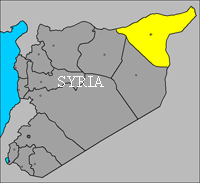Introduction:
Al Hasakah Governorate It is
situated in the far North-East of the Syrian Arab Republic.
It's about 23.300 k.m2. Its population is more than 1.050.000
persons. It is distinguished by the fertility of its lands,
plentiness of water, beauty of nature and the muchness of its
archaeological sites besides, its modern architectural and
civilizational growth and its numerous and useful agricultural and
industrial projects.
The most important river in Alhasaka is Alkhabour river which
springs from Ras Alayn, goes east toward Al-Hasaka, then goes
south to meet the Euphrates at Albsiera (Karkisia) in Dier Azzor
after passing Al-Hasaka governorate for about 440 km. Its stream
forms islands called Alhawaiej which are exploited as parks.
The most Important Cities at Al
Hasakah Governorate are:
Al Hasakah city: is the
capital of the Al Hasakah Governorate. Al
Hasakah has the second highest population in the governorate,
81,809, with the majority being Assyrians and Kurds. The town lies
on the banks of the Khabur River (a tributary of the Euphrates) at
its confluence with the Jaghjaghah.
It's characterized by the beauty of site, its modern architectural
and civilizational growth, and the different activities. There are
factories, economical projects, touristic institutions, and
different sport, cultural and educational activities.
Under the Ottoman Empire it lost its importance, but it revived
with the settlement there of Assyrian refugees from Iraq during
the French mandate of Siria after 1932. Now an important road
junction near the Turkish and Iraqi frontiers
Alqameshli city: It's
characterized by its straight streets, different activities,
touristic institutions and airport.
Almalkieh city: It's
characterized by the beauty of nature and the muchness of springs.
It contains the archaeological bridge goes back to 3th AC.
Also, there are important oil wells.
Ras Alayn: It looks like a
floating city on a lake of springs. There are, also, mineral
springs. Many well known persons in the history of civilization
came out of it.
Ayn Diwar: It looks out on Dejlah
River. It contains the remains of the archaeological bridge.
Around Al Hasakah
Tall Birak (Najar): Ancient site
located in the fertile Nahr al-Khabur basin in Al-Hasakah
governorate, Siria; it was inhabited from c. 3200 to c. 2200 BC.
One of the most interesting discoveries at Birak was the Eye
Temple (c. 3000), so named because of the thousands of small stone
“eye idols” found there.
Tall Birak is situated between Al-Hasaka and Al-Qameshli. The dig
started in 1937 – 1939. It was resumed after the 1st World War. It
showed six successive civilizational layers. King Naram Sin palace and Al-Ayoun temple
were the most important discovered buildings. Also, there are clay
findings, statues and cylindrical stamps which are rich in their
mythological subjects.
civilizational layers. King Naram Sin palace and Al-Ayoun temple
were the most important discovered buildings. Also, there are clay
findings, statues and cylindrical stamps which are rich in their
mythological subjects.
Tall Halaf (Gozana): In the
south of Ras Al'ain city, the dig revealed many successive
civilizational layers and beautiful basaltic statues which
decorated. the walls of the temple and the palace. Its clay was
known as (Halaf hill clay).
Tall Ajaja (Araban): It's
situated to the south of Al-Hasakah. It was an important centre on
the borders area between the Roman and Persian Empire. The old
city, whose ruins are in this hill, was one of the most cities in
Alkhabour Bed in the Abbasyeen Era.
Tall Shagher Bazar (Huteen):
It's situated in the north of Siria. The dig began in 1934. And it
is still continuing. It revealed 15 successive civilizational
layers. Its findings, clay plates, had supplied us by useful
information in the study of the history of the ancient east and
its civilizations.
Tall Lilan (shbat Enlil):
It's situated in the south of Al-qameshli; about 25 km. at
Alkhabour triangle area. The dig began in 1978. It revealed layers
which go back to 6000 B.C, the wall of the city, buildings such
as: the temple and the palace, clay plates, cylindrical stamps,
and various fictile ruins. All that made Lilan hill one of the
most important archaeological hills.
Tall Barri (Kaht): It's
situated on the eastern edge of Jaghjagh River. It's situated 8 km
far from Brak hill to the north. Tow important archaeological
carvings were found which helped recognizing the name of this site
(Kaht). It was the last stage of The Assyrian King's (Tokotly
Ninorta) conquest across the lands of Al-Jazeera in 885 B.C. His
tracks showed its importance.
Tall Mozan ( Orkiesh): It's
situated between Amoda and Alqameshli city. It includes an
archaeological city. At the beginning of 2000 B.C., the dig
revealed the city wall, the remains of stone building, stamps and
important different ruins.
Tall Alkhwieri: Between Ras
Alayn and Tal Abiad, the dig revealed an important stone temple,
buildings and fictile, metal and bony findings. The Acadian ax is
considered one of the most important finding. Also, there are many
important archaeological places such as Alamara hill, Baider hill
and the Ayyobian castle which is about 35 km far from Al-Hasaka
and situated on the northern side of Abd Alaziz Mountain. |